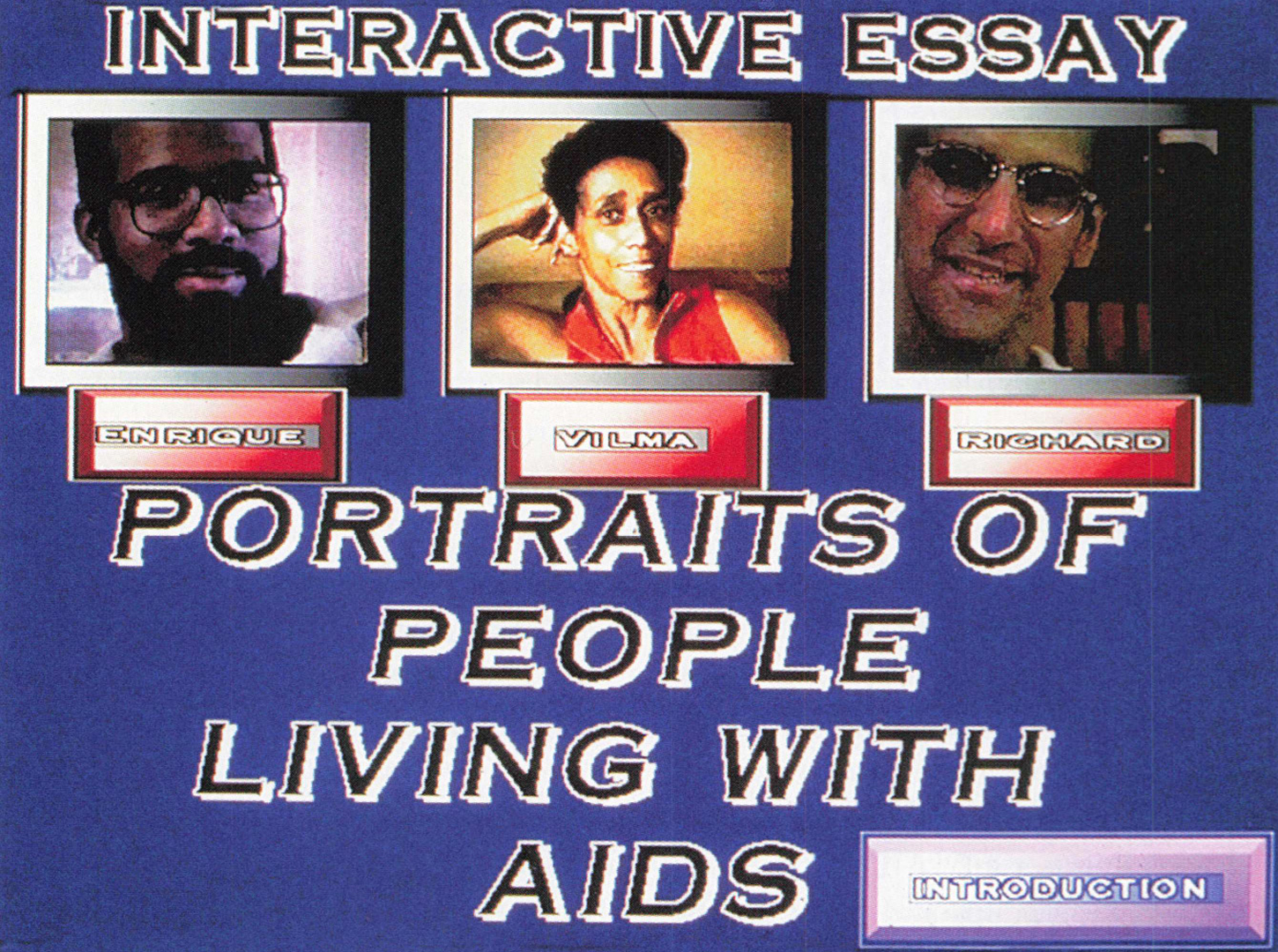“Portraits of People Living with AIDS” by Reed
Conference:
- SIGGRAPH 1993
-
More from SIGGRAPH 1993:


Type(s):
Entry Number: 44
Title:
- Portraits of People Living with AIDS
Program Title:
- Tomorrow's Realities
Presenter(s):
Description:
Portraits of People Living with AIDS seeks to involve users in an active understanding of the AIDS (Acquired Immune Deficiency Syndrome) condition. This interactive documentary introduces participants to three people living with AIDS (a male painter, a woman activist, and a male inner-city AIDS counselor) via audio, video clips and photographic essays stored digitally on a Macintosh computer. The portraits are grouped around conversations with each person, and topics, as in all conversations, are far-ranging. Because the interactive documentary is non-linear, a viewer may move from portrait to portrait allowing a more comfortable approach to this difficult topic. At any time within the portrait viewers may make their own personal observations by leaving a digital video message (via a video camera and digitizing board on the computer kiosk) for one of the three people or any of the previous viewers. In this way, each viewer continues the evolution of the documentary, allowing both interviewee and end users to have a voice in a personalized, intimate atmosphere of a computer kiosk.
The interactive documentary is a new medium that is based on a well-established communication mode, the dialog. Technologically, we have a long way to go before computer-interactive systems fully simulate the randomness that makes our daily conversations invigorating and lively; however, this project illustrates a first step toward interactive “computer conversations.”
The interactive essay Portraits of People Living with AIDS opens the door to this type of personal communication for several reasons. First, because it is game-like, users are put at ease-at least with the topic, if not the hardware. The now-familiar video-game format places the documentary in a readily accessible environment. Yet, while the computer interface is game-like, interactive essays are not predicated on the often destructive notion of winning. There is no right way to proceed in the program and, obviously, no wrong way. (This is an important reminder for face-to-face interaction, as well-without cautious and careful participant attention, conversations all too often turn into unbalanced monologues.) The non-domineering feature of the interactive format involves its participants in thoughtful regard of the information presented without chaining one to an unforgiving structure.
Portraits of People Living with AIDS recognizes AIDS as a human condition requiring human understanding. Such an understanding can come only through repeated efforts on the part of everyone involved, which in the case of HIV (Human Immune-deficiency virus) and AIDS includes almost everyone in our various communities. No human being on the planet is completely immune from this condition, yet we have all seen and heard the definitions of AIDS that serve to hold certain groups above the disease’s reach while focusing attention on others as though they were more susceptible. We have come to know AIDS as a disease of “this community” or of “that group.” These definitions have served to churn up the waters of prejudice and hatred. Despite attention-grabbing and often divisive public reactions, one fundamental element of the disease has been missed. AIDS is a human problem. In the words of Vilma Santiago, one of the people living with AIDS who appears in the piece, “AIDS does not discriminate.” Reaching out to a larger community to educate and inform poses a problem because of discriminatory definitions of AIDS. We must find ways to educate everyone without alienating them. We must make it clear that people with AIDS are part of our community. In short, we must come to see that each of us is as much a part of this disease as are the people who suffer directly from it.
Another important aspect of interactive essays is the opportunity for users to leave their own on-screen video messages. Participants can respond to any of the ideas or statements contained in the essay. This message-leaving aspect provokes an interesting reaction in the users. While they may feel comfortable listening to and watching the video clips, once they find they are an integral part of this expanding documentary, they may develop a more powerful recognition of the extent of their potential in the educational task of understanding AIDS. Likewise, this permits the participant to realize immediately the influence he or she has over the production of the essay. Thus the essay takes on a collaborative quality.
Interaction is nothing new; it is part of all communication. What is new is the interactive computer environment and how it involves the care and attention of all its participants. Understanding that viewers are part of the creation of meaning is an important notion in all communicative acts, be they face-to-face conversations with other human beings, interactions with the environment, or dialog with an interactive computer system. Communication, built on the notion of a caring self, results in a diligent acknowledgment of the contingent events that inform our lives. Computer interactive systems, designed with this human recognition in mind, may help us to better understand ourselves and the world in which we live.
Hardware
■ Macintosh Ouadra 800 with a RAM disk
■ 200 Mbytes hard drive
■ 24 bit color display card
■ 13″ color monitor (Apple or Sony)
■ Large-screen projector or large-screen high-resolution television monitor and signal converter
■ Syquest 88mg removable drive with at least one cartridge
■ Amplified speakers
■ Microphone




